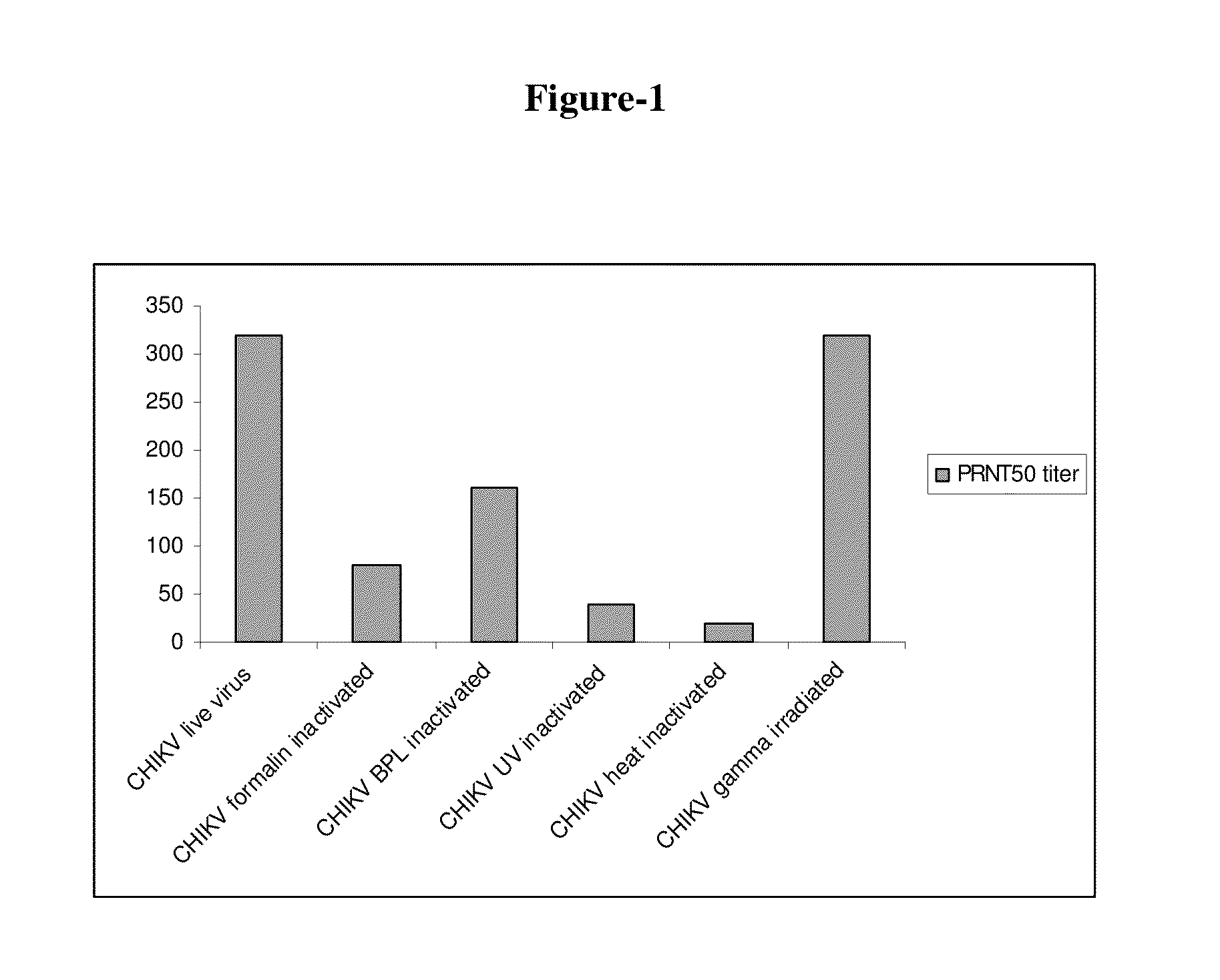Vaccine composition comprising an inactivated chikungunya virus strain
a technology of inactivated chikungunya virus and vaccine composition, which is applied in the field of stable immunogenic compositions, can solve the problems of human side effects and failure of dna vaccines, and achieve the effects of high immunological specificity, high incidence of chikv infection, and increased infectivity of sindbis virus
- Summary
- Abstract
- Description
- Claims
- Application Information
AI Technical Summary
Benefits of technology
Problems solved by technology
Method used
Image
Examples
example 1
Isolation of Virus Strains
[0041]The virus strains were isolated from blood samples collected from febrile patients with their informed consent during an epidemic outbreak in India in 2009-2010. The blood samples were collected during the acute phase of Chikungunya virus infection when patients reported high fever, acute polyarthralgia and painful swelling in joints and rashes. The patients' sera samples were transported on dry ice to the laboratory. About 0.05 ml of the serum was used for infection of Vero cells (ATCC No. CCL-81) in 252 cm flask in medium containing DMEM (Dulbecco's Modified Eagle Medium; Sigma—Aldrich Catalog #D5523) containing 1% fetal bovine serum (FBS). The flasks were incubated at 34° C. to 37° C. The virus was harvested 48 hours after infection. Scaled up cultures of the virus were made in cell stacks or in cell factories or in bioreactors in liquid culture All the blood samples were negative for Dengue infection by specific IgM ELISA (National Institute of Vi...
example 2
Purification and Inactivation of CHIKV Virus
[0042]The two virus isolates TN01610 and TN15110 were purified from the infected Vero cell monolayers from scaled up cultures by initial ultrafiltration to remove cellular debris, and by filtration and concentration through a 300 kD membrane followed by purification by ion exchange and gel filtration column chromatography. Heat inactivation of the virus was carried out at different temperatures ranging from 45° C. to 60° C. for 30 min to 4 hrs and optimally at 56° C. for 30 min. Inactivation by ultraviolet (UV) light was done at 254 nm for varying period of time from 30-120 min on ice, and optimally for 40 min. Chikungunya virus was inactivated effectively by formalin at ratios upto 1:3000 for formalin:virus at 2° C. -8° C. upto 7 days, and with beta propiolactone at 1:1000 to 1:2500 (beta propiolactone:virus) for upto 7 days at 2° C.-8° C. In both the cases, the time of inactivation was reduced to 24-48 hrs when carried out at ambient tem...
example 3
Reverse Transcriptase—Polymerase Chain Reaction (RT-PCR) and Sequencing
[0043]Viral RNA was isolated using Absolutely RNA Miniprep kit (Stratagene, La Jolla, Calif.) from infected Vero cells (ATCC CCL-81), after a single passage. RT-PCR was carried out using the AccuScript High Fidelity 1st Strand cDNA Synthesis Kit (Stratagene) as per the kit protocols, and the 3,747 bp structural polyprotein gene was amplified with the PfuUltra High-Fidelity DNA polymerase (Stratagene). PCR primers were designed based on the consensus sequence of the S27-African prototype (AF369024) and the Indian 2006 isolate (HM159384), and used to amplify overlapping sequences of the structural polyprotein gene. PCR reaction consisted of initial denaturation at 95° C. for 1 min, followed by 32 thermal cycling steps at 94° C. for 40 sec, annealing at 52-65° C. (depending on the primer sets) for 30 sec and extension at 70° C. for 3 min, followed by final extension at 70° C. for 10 min. PCR products were purified b...
PUM
| Property | Measurement | Unit |
|---|---|---|
| temperatures | aaaaa | aaaaa |
| temperature | aaaaa | aaaaa |
| temperatures | aaaaa | aaaaa |
Abstract
Description
Claims
Application Information
 Login to View More
Login to View More - R&D
- Intellectual Property
- Life Sciences
- Materials
- Tech Scout
- Unparalleled Data Quality
- Higher Quality Content
- 60% Fewer Hallucinations
Browse by: Latest US Patents, China's latest patents, Technical Efficacy Thesaurus, Application Domain, Technology Topic, Popular Technical Reports.
© 2025 PatSnap. All rights reserved.Legal|Privacy policy|Modern Slavery Act Transparency Statement|Sitemap|About US| Contact US: help@patsnap.com


